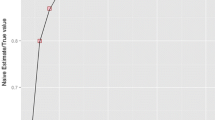Abstract
Purpose. The intent was to investigate three direct curve comparison metrics, the Rescigno Index,f1, and the Chinchilli Metric as tools to assess relative bioavailablity (BA) and bioequivalence (BE). The specific objectives were to 1) estimate relative bioavailability and bioequivalence and 2) compare detection of profile shape differences with typical (i.e. AUC and Cmax) criteria.
Methods. Product bioequivalence was estimated and the degree of concordance with typical criteria in detecting profile differences was determined from the eighteen bioequivalence studies (390 subjects). Descriptive statistical analysis was carried out on the concordant and discordant profile subsets.
Results. 1) Three of the eighteen studies failed typical criteria (AUC and Cmax). Of the curve metrics, 12 studies failed the Chinchilli metric criteria and 13 failed fl criteria. Using three different exponents in the Rescigno Index calculation, 17 (exponent = 3), 13 (exponent = 1), and 11 (exponent = 1/3) failed the criteria for bioequivalence. The frequency of profiles found to be different was comparable across the metrics, but the specific profiles found to be different or not different varied across the metrics. The Chinchilli Metric and fl agreed 71 % and 72% with typical criteria in judging profiles to be different or not different. Descriptive evaluation suggested that the direct curve metrics more effectively detect differences in absorption time lags but less effectively detect differences in Cmax. The Rescigno Index showed dependence on the direction of the difference between test and reference concentrations.
Conclusions. With the limits used here, the direct curve metrics represent a more conservative approach to evaluate product bioequivalence. With further investigation and development, the direct curve approach may be used effectively to evaluate relative BA and BE.
Similar content being viewed by others
REFERENCES
F. Y. Bois, T. N. Tozer, W. W. Hauck, M. Chen, R. Patnaik, and R. L. Williams. Pharm. Res. 11:966-974 (1994).
L. Endrenyi, S. Fritsch, and W. Yan. Int. J. Clin. Pharm., Ther. and Tox. 29:394-399 (1991).
J. Zha, L. Tothfalusi, and L. Endrenyi. Drug Inf. J. 29:989-996 (1995).
B. Rostami-Hodjegan, P. R. Jackson, and G. T. Tucker. J. Pharm. Sci. 11:1554-1558 (1994).
A. Rescigno. Pharm. Res. 9:925-928 (1992).
J. W. Moore and H. H. Flanner. Pharm. Tech. 20:64-74 (1996).
V. M. Chinchilli and R. K. Elswick, Jr. J. Biopharm. Stat. 7:113-123 (1997).
J. E. Polli, G. S. Rekhi, L. L. Augsburger, and V. P. Shah. J. Pharm. Sci. 86:690-700 (1997).
Mei-Ling Chen. Pharm. Res. 9:1380-1385 (1992).
A. W. Boddy, F. C. Snikeris, R. O. Kringle, G. C. G. Wei, J. A. Oppermann, and K. K. Midha. Pharm. Res. 12:1865-1868 (1995).
Author information
Authors and Affiliations
Corresponding author
Rights and permissions
About this article
Cite this article
Marston, S.A., Polli, J.E. Evaluation of Direct Curve Comparison Metrics Applied to Pharmacokinetic Profiles and Relative Bioavailability and Bioequivalence. Pharm Res 14, 1363–1369 (1997). https://doi.org/10.1023/A:1012160419520
Issue Date:
DOI: https://doi.org/10.1023/A:1012160419520



